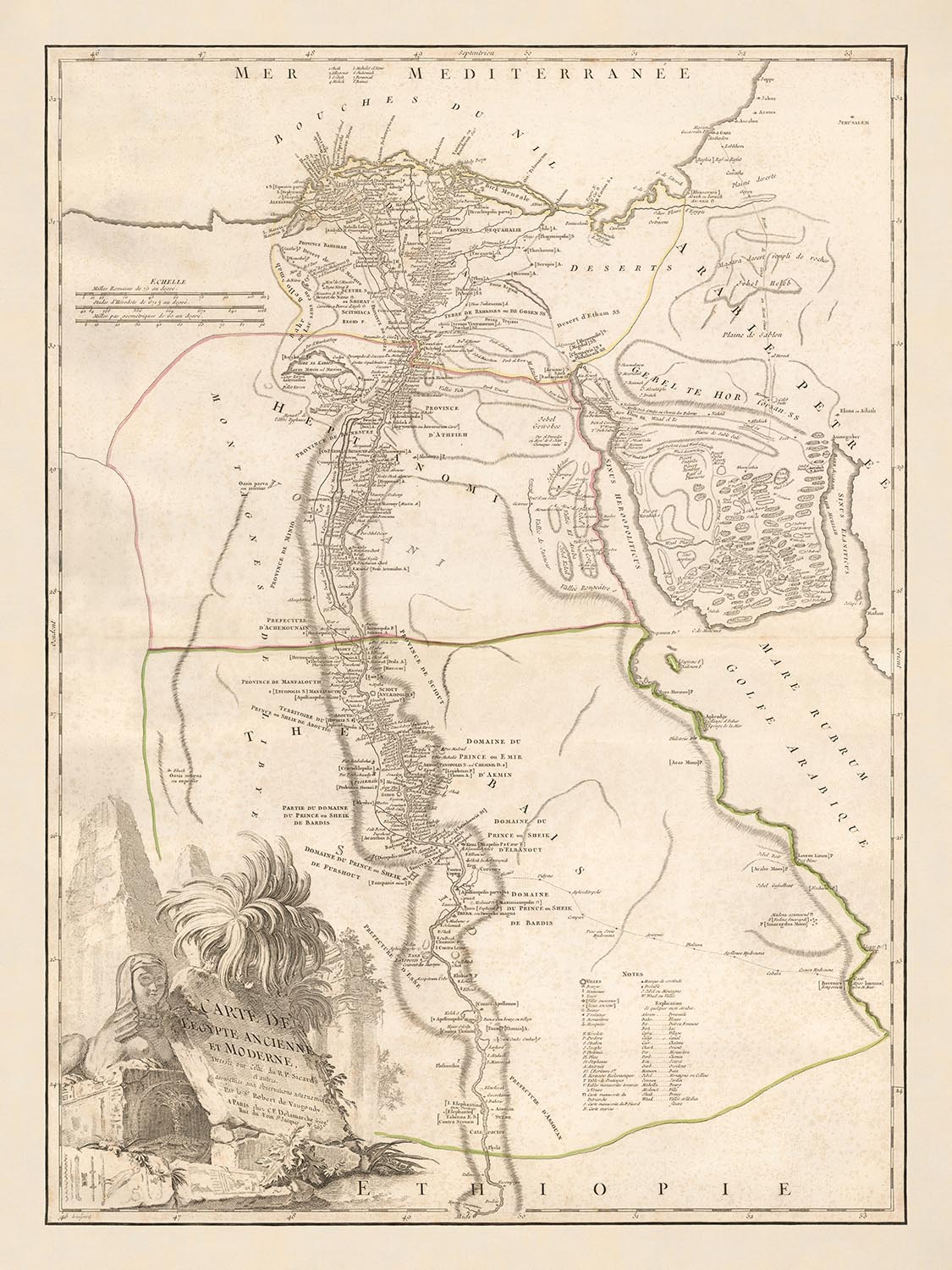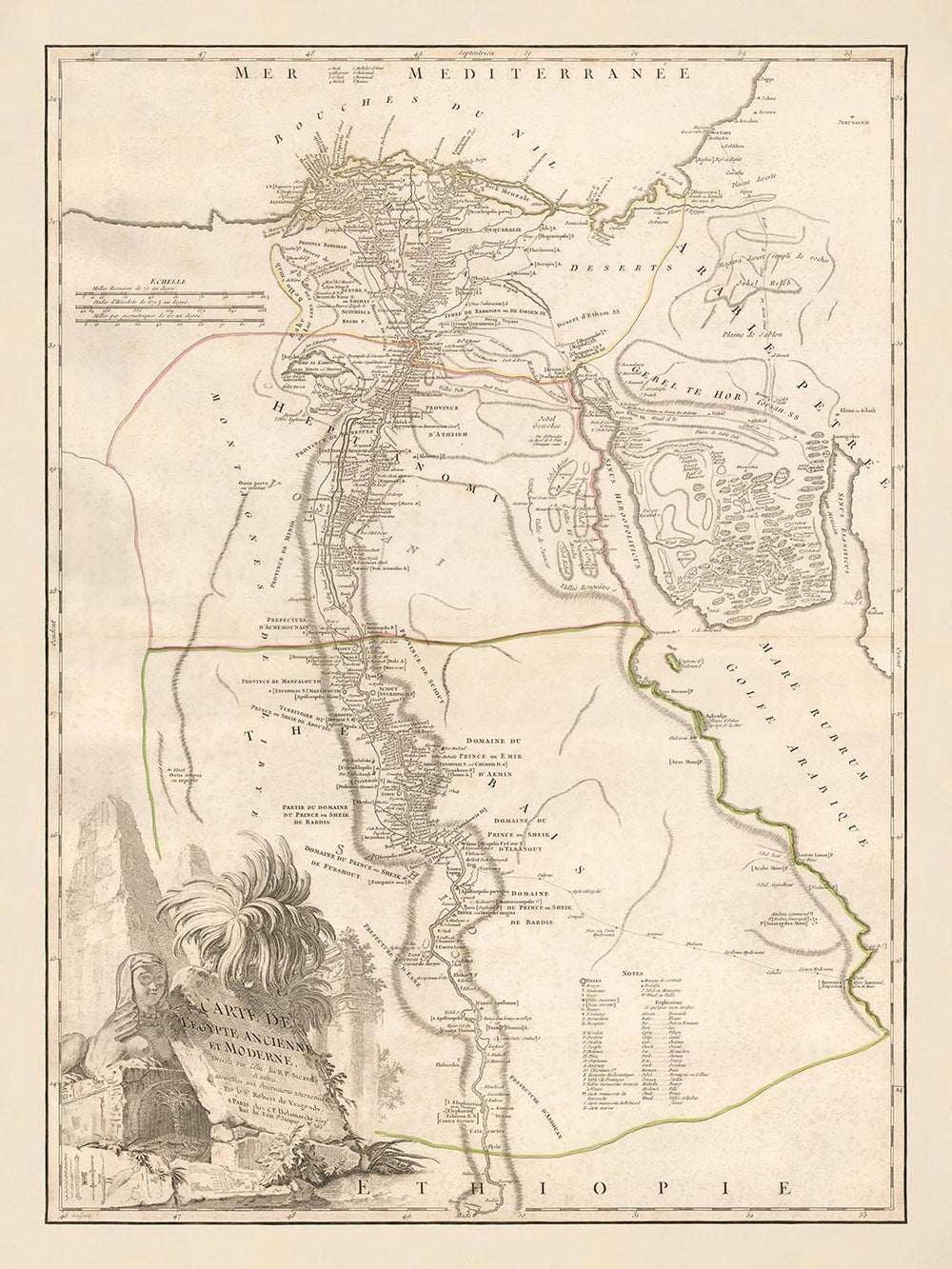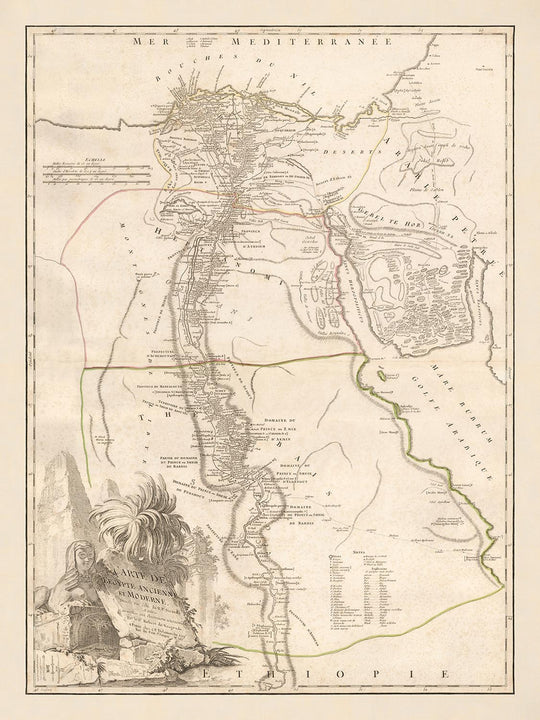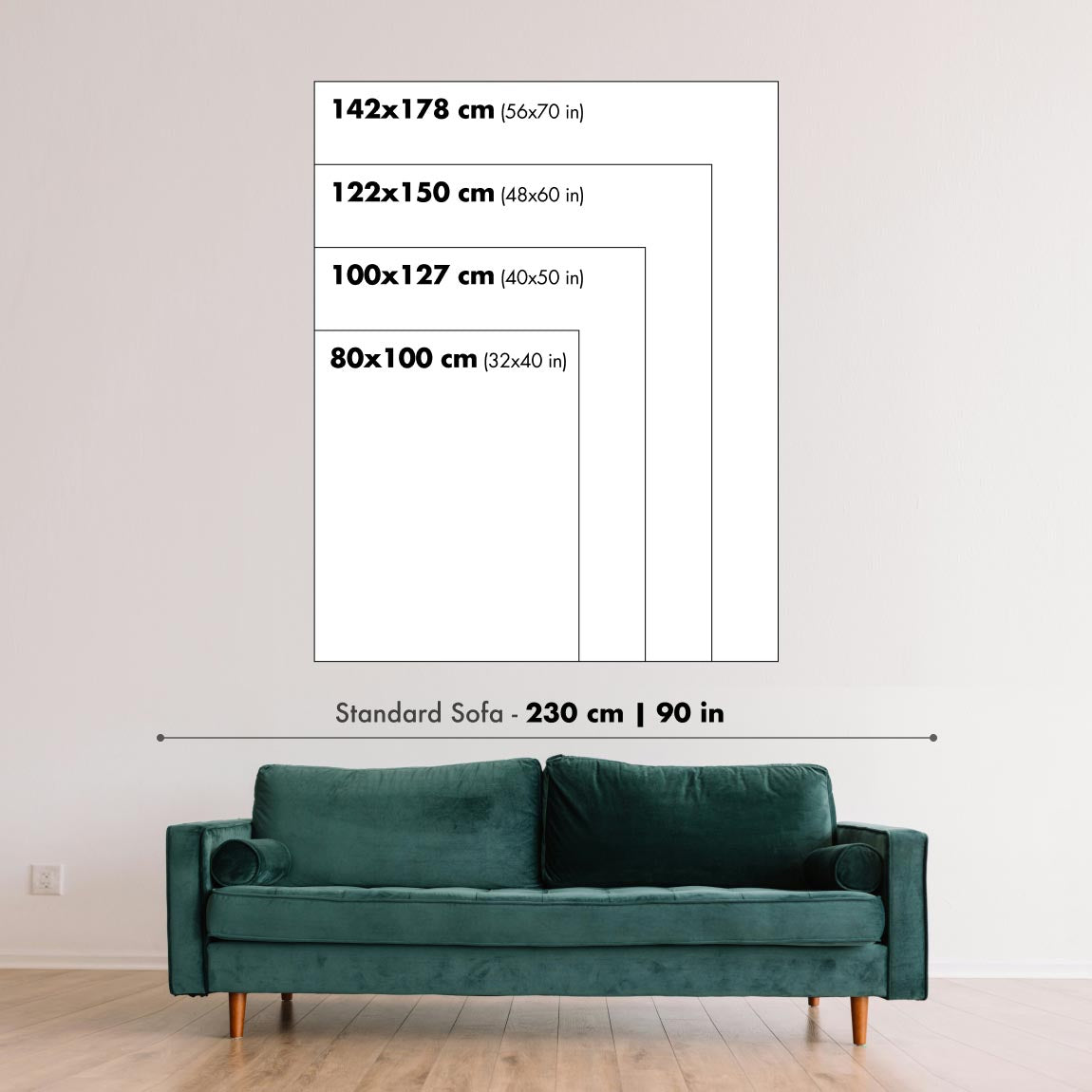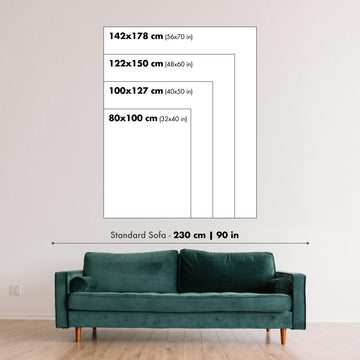- Handmade locally. No import duty or tax
- FREE worldwide delivery
- Love it or your money back (90 days)
- Questions? WhatsApp me any time
Own a piece of history
5,000+ 5 star reviews


Introducing the exquisite "Carte De L'Egypte Ancienne et Moderne Dressee sure Celle du R.P. Sicard et autres," a masterful creation by the renowned 18th-century French geographer Charles Francois Delamarche. Crafted in 1757, this map offers a captivating glimpse into the ancient and modern landscapes of Egypt, meticulously detailing the Nile River Valley and Delta. The map is a testament to Delamarche's dedication to cartographic precision and his ability to weave historical narratives into geographical representations. It stands as a remarkable fusion of art and science, inviting viewers to explore the rich tapestry of Egypt's storied past.
Delamarche's map is based on the pioneering reports of Father Claude Sicard, a French Jesuit priest who ventured into Egypt between 1708 and 1712. Sicard's observations and the earliest known map of Egypt provided the foundation for this detailed cartographic masterpiece. The map not only identifies place names with both ancient and modern nomenclature but also highlights significant trading routes, particularly the vital corridor between the Red Sea and the Nile. This focus on trade underscores the historical importance of Egypt as a nexus of commerce and culture.
The map is adorned with an elaborate cartouche, featuring allegorical representations of the Pyramids, the Sphinx, and other symbols of ancient Egypt. This decorative element adds a layer of artistic elegance, drawing the viewer's eye and providing a visual anchor for the historical narrative depicted. The detailed engraving showcases the Nile River's meandering path, its fertile delta, and the surrounding deserts, offering a comprehensive view of the region's geography. The inclusion of ancient temples and ruins further enriches the map, providing insights into Egypt's architectural and cultural heritage.
In addition to its artistic and historical value, the map serves as a detailed geographical record, marking the locations of numerous cities and towns. From the bustling metropolis of Cairo to the ancient city of Thebes (modern-day Luxor), the map captures the essence of Egypt's urban landscape. It also highlights significant landmarks such as Memphis, Heliopolis, and the famed Rosetta (Rashid), each with its own unique historical significance. The meticulous labeling of these settlements provides a window into the past, offering a snapshot of Egypt's development over millennia.
The map's depiction of natural features is equally impressive, with the Nile River and its delta prominently featured alongside the Red Sea and the Mediterranean. The representation of mountain ranges and regional borders adds depth to the geographical context, illustrating the diverse terrain that has shaped Egypt's history. This combination of natural and man-made elements creates a rich, layered narrative that invites exploration and discovery. Delamarche's map is not just a geographical tool; it is a historical document that captures the essence of Egypt's enduring legacy.
Cities and towns on this map
- Cairo (Al-Qahira)
- Alexandria
- Giza
- Luxor (Thebes)
- Aswan
- Memphis
- Heliopolis
- Sais
- Tanis
- Abydos
- Dendera
- Edfu
- Philae
- Kom Ombo
- Karnak
- Elephantine
- Rosetta (Rashid)
- Damietta (Dumyat)
- Suez (Suweis)
- Faiyum (Crocodilopolis)
- Minya
- Beni Suef
- Qena
- Sohag
- Assiut
- Qus
- Esna
- El-Kab
Notable Features & Landmarks
- Illustrations:
- Elaborate cartouche with allegorical representations of the Pyramids, the Sphinx, and ancient Egypt.
- Landmarks:
- Pyramids
- Sphinx
- Ancient temples and ruins
- Bodies of water:
- Nile River
- Nile Delta
- Red Sea (Mare Rubrum)
- Mediterranean Sea (Mer Mediterranee)
- Borders:
- Various regional borders indicated with colored lines.
- Mountains:
- Some mountain ranges and elevations indicated, though not prominently featured.
Historical and design context
- Edition: C F Delamarche edition of the Robert de Vaugondy map of Egypt.
- Place names: Identifies place names with both ancient and modern names.
- Labels: Cities and ancient temples/ruins are labelled.
- Trading route: Shows the main trading route from the Red Sea to the Nile.
- Detail: Excellent detail in the Nile River Valley and Nile Delta.
- Cartouche: Features an elaborate cartouche showing allegorical representations of the Pyramids, the Sphinx, and ancient Egypt.
- Source: Based on the reports of Father Claude Sicard, a French Jesuit priest and early modern visitor to Egypt between 1708 and 1712.
- Earliest map: Sicard produced the earliest known map of Egypt during his time as the Supervisor of the Jesuit Mission in Cairo.
- Date created: 1757
- Mapmaker/Publisher: Charles Francois Delamarche
- Context about the mapmaker: Delamarche was a prominent French geographer and map publisher in the 18th century.
- Topics and themes shown on the map:
- Ancient and modern place names: Reflects the historical evolution of place names.
- Trading routes: Highlights the significance of trade in the region, especially between the Red Sea and the Nile.
- Geographical features: Detailed depiction of the Nile River Valley and Delta.
- Historical landmarks: Includes representations of ancient temples and ruins.
- Countries and regions shown on the map: Primarily Egypt, with some surrounding regions.
- Design and style:
- Elaborate cartouche: Decorative cartouche with allegorical elements.
- Detailed engraving: High level of detail in geographical and man-made features.
- Historical significance:
- Early cartography: One of the earliest detailed maps of Egypt.
- Cultural heritage: Reflects the historical and cultural landscape of ancient and modern Egypt.
- Jesuit contributions: Based on the pioneering work of Father Claude Sicard.
Please double check the images to make sure that a specific town or place is shown on this map. You can also get in touch and ask us to check the map for you.
This map looks great at every size, but I always recommend going for a larger size if you have space. That way you can easily make out all of the details.
This map looks amazing at sizes all the way up to 100in (250cm). If you are looking for a larger map, please get in touch.
Please note: the labels on this map are hard to read if you order a map that is 16in (40cm) or smaller. The map is still very attractive, but if you would like to read the map easily, please buy a larger size.
The model in the listing images is holding the 18x24in (45x60cm) version of this map.
The fifth listing image shows an example of my map personalisation service.
If you’re looking for something slightly different, check out my collection of the best old maps to see if something else catches your eye.
Please contact me to check if a certain location, landmark or feature is shown on this map.
This would make a wonderful birthday, Christmas, Father's Day, work leaving, anniversary or housewarming gift for someone from the areas covered by this map.
This map is available as a giclée print on acid free archival matte paper, or you can buy it framed. The frame is a nice, simple black frame that suits most aesthetics. Please get in touch if you'd like a different frame colour or material. My frames are glazed with super-clear museum-grade acrylic (perspex/acrylite), which is significantly less reflective than glass, safer, and will always arrive in perfect condition.
This map is also available as a float framed canvas, sometimes known as a shadow gap framed canvas or canvas floater. The map is printed on artist's cotton canvas and then stretched over a handmade box frame. We then "float" the canvas inside a wooden frame, which is available in a range of colours (black, dark brown, oak, antique gold and white). This is a wonderful way to present a map without glazing in front. See some examples of float framed canvas maps and explore the differences between my different finishes.
For something truly unique, this map is also available in "Unique 3D", our trademarked process that dramatically transforms the map so that it has a wonderful sense of depth. We combine the original map with detailed topography and elevation data, so that mountains and the terrain really "pop". For more info and examples of 3D maps, check my Unique 3D page.
For most orders, delivery time is about 3 working days. Personalised and customised products take longer, as I have to do the personalisation and send it to you for approval, which usually takes 1 or 2 days.
Please note that very large framed orders usually take longer to make and deliver.
If you need your order to arrive by a certain date, please contact me before you order so that we can find the best way of making sure you get your order in time.
I print and frame maps and artwork in 23 countries around the world. This means your order will be made locally, which cuts down on delivery time and ensures that it won't be damaged during delivery. You'll never pay customs or import duty, and we'll put less CO2 into the air.
All of my maps and art prints are well packaged and sent in a rugged tube if unframed, or surrounded by foam if framed.
I try to send out all orders within 1 or 2 days of receiving your order, though some products (like face masks, mugs and tote bags) can take longer to make.
If you select Express Delivery at checkout your order we will prioritise your order and send it out by 1-day courier (Fedex, DHL, UPS, Parcelforce).
Next Day delivery is also available in some countries (US, UK, Singapore, UAE) but please try to order early in the day so that we can get it sent out on time.
My standard frame is a gallery style black ash hardwood frame. It is simple and quite modern looking. My standard frame is around 20mm (0.8in) wide.
I use super-clear acrylic (perspex/acrylite) for the frame glass. It's lighter and safer than glass - and it looks better, as the reflectivity is lower.
Six standard frame colours are available for free (black, dark brown, dark grey, oak, white and antique gold). Custom framing and mounting/matting is available if you're looking for something else.
Most maps, art and illustrations are also available as a framed canvas. We use matte (not shiny) cotton canvas, stretch it over a sustainably sourced box wood frame, and then 'float' the piece within a wood frame. The end result is quite beautiful, and there's no glazing to get in the way.
All frames are provided "ready to hang", with either a string or brackets on the back. Very large frames will have heavy duty hanging plates and/or a mounting baton. If you have any questions, please get in touch.
See some examples of my framed maps and framed canvas maps.
Alternatively, I can also supply old maps and artwork on canvas, foam board, cotton rag and other materials.
If you want to frame your map or artwork yourself, please read my size guide first.
My maps are extremely high quality reproductions of original maps.
I source original, rare maps from libraries, auction houses and private collections around the world, restore them at my London workshop, and then use specialist giclée inks and printers to create beautiful maps that look even better than the original.
My maps are printed on acid-free archival matte (not glossy) paper that feels very high quality and almost like card. In technical terms the paper weight/thickness is 10mil/200gsm. It's perfect for framing.
I print with Epson ultrachrome giclée UV fade resistant pigment inks - some of the best inks you can find.
I can also make maps on canvas, cotton rag and other exotic materials.
Learn more about The Unique Maps Co.
Map personalisation
If you're looking for the perfect anniversary or housewarming gift, I can personalise your map to make it truly unique. For example, I can add a short message, or highlight an important location, or add your family's coat of arms.
The options are almost infinite. Please see my map personalisation page for some wonderful examples of what's possible.
To order a personalised map, select "personalise your map" before adding it to your basket.
Get in touch if you're looking for more complex customisations and personalisations.
Map ageing
I have been asked hundreds of times over the years by customers if they could buy a map that looks even older.
Well, now you can, by selecting Aged before you add a map to your basket.
All the product photos you see on this page show the map in its Original form. This is what the map looks like today.
If you select Aged, I will age your map by hand, using a special and unique process developed through years of studying old maps, talking to researchers to understand the chemistry of aging paper, and of course... lots of practice!
If you're unsure, stick to the Original colour of the map. If you want something a bit darker and older looking, go for Aged.
If you are not happy with your order for any reason, contact me and I'll get it fixed ASAP, free of charge. Please see my returns and refund policy for more information.
I am very confident you will like your restored map or art print. I have been doing this since 1984. I'm a 5-star Etsy seller. I have sold tens of thousands of maps and art prints and have over 5,000 real 5-star reviews. My work has been featured in interior design magazines, on the BBC, and on the walls of dozens of 5-star hotels.
I use a unique process to restore maps and artwork that is massively time consuming and labour intensive. Hunting down the original maps and illustrations can take months. I use state of the art and eye-wateringly expensive technology to scan and restore them. As a result, I guarantee my maps and art prints are a cut above the rest. I stand by my products and will always make sure you're 100% happy with what you receive.
Almost all of my maps and art prints look amazing at large sizes (200cm, 6.5ft+) and I can frame and deliver them to you as well, via special oversized courier. Contact me to discuss your specific needs.
Or try searching for something!







